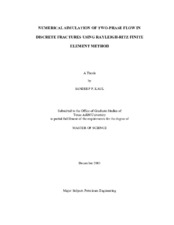| dc.description.abstract | Spontaneous imbibition plays a very important role in the displacement mechanism of non-wetting fluid in naturally fractured reservoirs. We developed a new 2D two-phase finite element numerical model, as available commercial simulators cannot be used to model small-scale experiments with different boundary conditions as well as complex boundary conditions such as fractures and vugs. Starting with the basic equation of fluid flow, we derived the non-linear diffusion saturation equation. This equation cannot be put in weighted-integral weak variational form and hence Rayleigh-Ritz finite element method (FEM) cannot be applied. Traditionally, the way around it is to use higher order interpolation functions and use Galerkin FEM or reduce the differentiability requirement and use Mixed FEM formulation. Other FEM methods can also be used, but iterative nature of those methods makes them unsuitable for solving large-scale field problems. But if we truncate the non-linear terms and decouple the dependent variables, from the spatial as well as the temporal domains of the primary variable to solve them analytically, the non-linear FEM problem reduces to a simple weighted integral form, which can be put into its corresponding weak form. The advantage of using Rayleigh-Ritz method is that it has immediate effect on the computation time required to solve a particular problem apart from incorporating complex boundary conditions. We compared our numerical models with the analytical solution of this diffusion equation. We validated the FDM numerical model using X-Ray Tomography (CT) experimental data from the single-phase spontaneous imbibition experiment, where two simultaneously varying parameters of weight gain and CT water saturation were used and then went ahead and compared the results of FEM model to that of FDM model. A two-phase field size example was taken and results from a commercial simulator were compared to the FEM model to bring out the limitations of this approach. | en |


